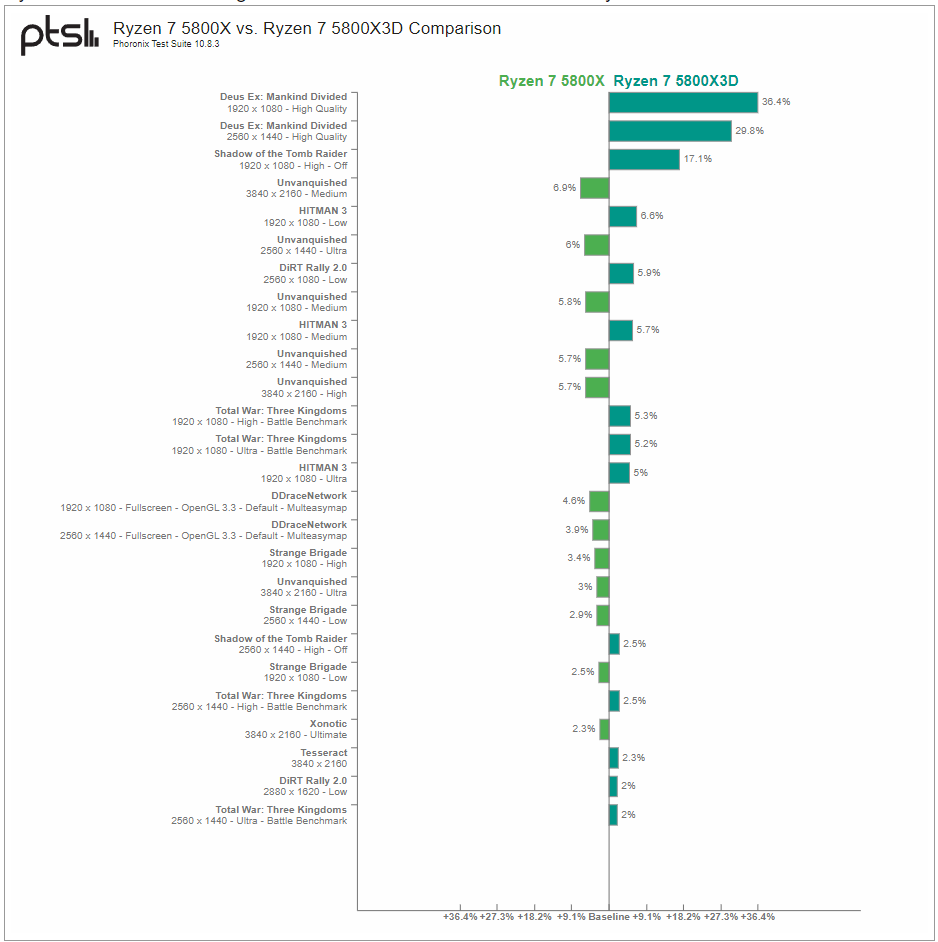AMD Ryzen 7 5800X3D Gaming Performance Falters on Linux
A surprising twist for AMD's "Gaming-focused" V-Cache CPUs
Phoronix recently tested AMD's new Ryzen 7 5800X3D V-Cache CPU on Linux and found wildly different results compared to Windows. The most significant change came with Linux gaming performance, where the 5800X3D's extra L3 cache that has propelled it to the position of the best gaming CPU in Windows wasn't that useful compared to games running on Windows.
On the flip side, several other applications that aren't related to gaming, including oneDNN, Lczero, and NCNN, benefited greatly from the additional cache on Linux.
The Ryzen 7 5800X3D is AMD's first processor with a stacked L3 cache, known as V-Cache technology. This stacking technique allows AMD to triple the amount of L3 cache available to its Zen 3 CPU, giving the processor a substantial amount of performance potential in applications that can take advantage of the additional cache capacity.
For mainstream consumers, the largest benefit people will see from the 5800X3D is in gaming performance, where we saw a 21% increase in performance over standard Zen 3 chips, including the 5900X on Windows 11. However, we saw almost no benefit of the additional L3 cache in other mainstream desktop applications.
This is where Phoronix's testing comes as a surprise. In tests run under Ubuntu 22.04, Phoronix found little difference in gaming performance compared to the standard Ryzen 7 5800X. The only outliers were Shadow of the Tomb Raider and Deus Ex Mankind Divided, which eeked out a 17.1% and 36.4% difference, respectively.
For the rest of the 15 games tested -- including Total War: Three Kingdoms, Hitman 3, Strange Brigade, and more -- the performance comparisons averaged 5% at best in favor of the 5800X3D. Testing was performed with a Radeon RX 6800 XT, with resolutions ranging from 1080P to 1440P and 4K.
For reference, in our testing, we found our entire suite of games averaged a 28% performance improvement with the 5800X3D compared to the 5800X at 1080P on Windows. In fairness, we did use an RTX 3090 in our testing. However, the performance difference is large enough that the differences in GPUs shouldn't entirely make up for the FPS differences.
Get Tom's Hardware's best news and in-depth reviews, straight to your inbox.

Non-Gaming Linux Benchmarks
Unsurprisingly, the 5800X3D did very well compared to the standard 5800X in professional HPC applications, such as LeelaChessZero and NAS Parallel, OpenFOAM 8, and Xcompact3D. It won by as much as 118% in some applications.
In compression, code compilation, VP9, and AV1 tests, performance behavior was the same, with the 5800X3D coming out on top in every benchmark. In some instances, the 5800X3D won by a landslide and even beat the 16-core 5950X.
This truly shows how L3 cache intensive most of these professional applications can be and why AMD launched an entire lineup of 3D V-cache server chips codenamed Milan-X.
However, before someone takes these results out of context, these incredible performance gains are only tangible in professional and gaming applications that can take full advantage of the bigger L3 cache.
Not all applications benefit from V-Cache, and this is particularly true of mainstream desktop applications, with the only exception being gaming. Even then, not all games see significant performance benefits with V-Cache, even on Windows.
However, the amount of games that cannot take full advantage of the 5800X3D's V-Cache on Linux compared to Windows is quite surprising. Hopefully, we'll get an answer soon as to why this is the case.

Aaron Klotz is a contributing writer for Tom’s Hardware, covering news related to computer hardware such as CPUs, and graphics cards.
-
hotaru.hino The benchmarks used were either AI benchmarks, physics simulations, or in the NAS Parallels Benchmark... I'm not going to try to understand what it's doing outside of things of importance to scientific based HPC work.Reply
The AI and physics simulation benchmarks I can see reusing the same memory locations. -
ikernelpro4 Reply
2 year old article but Phoronix isn't just "someone" mate....They are quite literally the tomshardware of linux.....chalabam said:Tomshardware in 2010: "We tested..."
Tomshardware in 2020: "Somebody tested..."